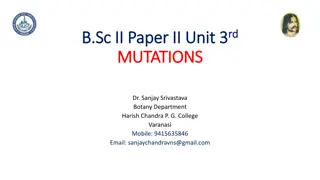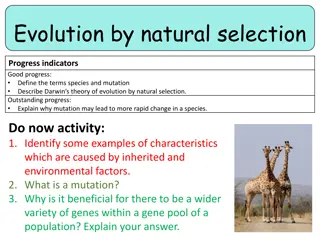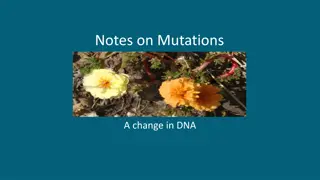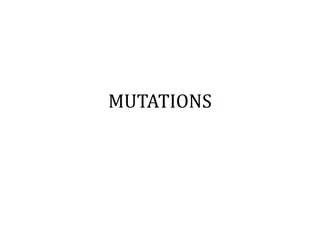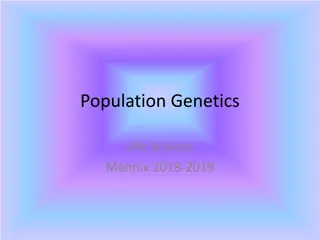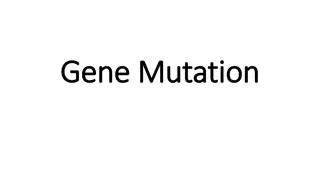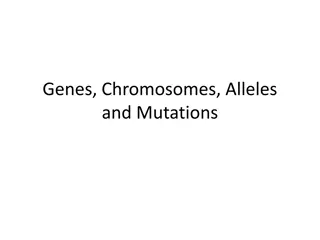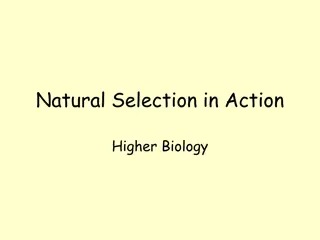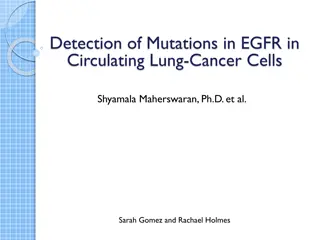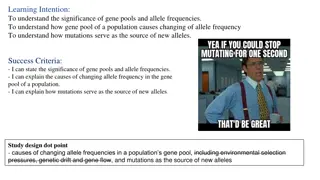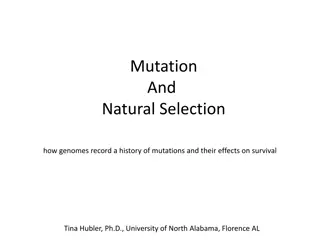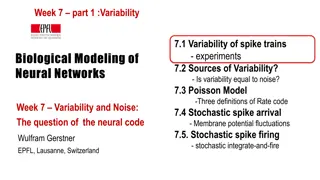Understanding Population Genetics: Mutations, Variability, and Evolution
Explore the fascinating world of population genetics, covering key concepts like the history of population genetics, mutation types, measurement of variability, and mutation rates. Delve into the diverse mutations such as substitutions, insertions, deletions, and duplications, along with how these variations impact genetic diversity. Discover the significance of mutation rates and how variability is measured in populations. Gain insights into the fundamental aspects of natural selection, the Wright-Fisher model, and the molecular clock in population genetics studies.
Download Presentation

Please find below an Image/Link to download the presentation.
The content on the website is provided AS IS for your information and personal use only. It may not be sold, licensed, or shared on other websites without obtaining consent from the author. Download presentation by click this link. If you encounter any issues during the download, it is possible that the publisher has removed the file from their server.
E N D
Presentation Transcript
Institute of Zoology, Chinese Academy of Sciences, Population Genetics in a nutshell: Part II Beijing, China Dec 2018 University of Science and Technology of China
Lets start with a team of 2 (Team based learning) Can you retake seats among yourself and seat with someone you don t know. Can you take 2-3 minutes to get to introduce to your friend: who you are.
A quick overview of what we have covered previously 1) The history of population genetics: Darwin, the genetic basis of inheritance, the discovery and rediscovery of Mendelian genetics. The conflict between Biometricians and Mendelian geneticists, the rise of population genetics through the efforts of R.A. Fisher, The three founders of Population Genetics 2) Key concepts in Population genetics and HWE: The scope of population genetics, the concept of HWE, assumptions of HWE, How to test for HWE 3) Natural selection and deterministic theory: Viability selection, how to model natural selection when population size is very large (i.e. deterministic theory), Fundamental theory of natural selection 4) Finite populations and the Wright Fisher model: the concept of WF model (random sampling, i.e. multinomial sampling), genetic drift, the long term fate of an allele, fixation probability, time to fixation, the effective population size.
2.4 Mutation, measures of variability, mutation drift balance, Molecular Clock
Types of mutations Substitution: change in one DNA base pair from one base to another. Insertion: changes the number of DNA bases in a gene by adding a piece of DNA. As a result, the protein made by the gene may not function properly. Deletion: changes the number of DNA bases by removing a piece of DNA. Small deletions may remove one or a few base pairs within a gene, while larger deletions can remove an entire gene or several neighboring genes. The deleted DNA may alter the function of the resulting protein(s). Duplication: consists of a piece of DNA that is abnormally copied one or more times. This type of mutation may alter the function of the resulting protein.
Mutation rate Let s focus on the simple substitutions for now. There are many possible ways we measure mutation rate. The most classical measurement is probability of mutation per site per generation (often denoted as ). The mutation rate for humans is around 1.8*10-8per site per generation.
Measurement of variability: When you sample two genes/sequences from the population and compare their nucleotide sequences, there will be some differences between them. Ideally, more heterogenous populations, you will see higher numbers of differences. A common measurement is average percentage of differences between two sequences. This is often called = percentage of differences between two sequences. For human population, this value is around 0.001. Sometimes, we also call this heterozygosity (at the base level).
Mutation drift balance Genetic drift will purge the variation, but mutation will keep introducing mutations, there will be a mutation-drift balance. Through some non-trivial exercise, we can prove that is approximately 4Ne where is the is the percentage of difference between sequences (observed). This provides an intrinsic link between observed data ( ) and population parameters. The effective population size of humans is on the order of 104 (10,000).
Molecular Clock The notion of the existence of a so-called "molecular clock" was first attributed to mile Zuckerkandl and Linus Pauling who, in 1962, noticed that the number of amino acid differences in hemoglobin between different lineages changes roughly linearly with time, as estimated from fossil evidence
How to derive the Molecular Clock? How many mutations are introduced in each generation for a population of size N? When a mutation is introduced, what s the frequency of the mutation? What s the probability of new mutations being fixed in the population?
Stabilizing selection When selective pressures select against the two extremes of a trait, the population experiences stabilizing selection.
Directional selection In directional selection, one extreme of the trait distribution experiences selection against it. The result is that the population's trait distribution shifts toward the other extreme.
Diversifying (Disruptive) selection In disruptive selection, selection pressures act against individuals in the middle of the trait distribution. The result is a bimodal, or two-peaked,
Frequency dependent selection Frequency-dependent Selection: selection favors phenotypes that are either common (positive frequency-dependent selection) or rare (negative frequency-dependent selection).
Sexual selection The selection pressures on males and females to obtain matings is known as sexual selection. Sexual selection takes two major forms: intersexual selection (also known as mate choice or female choice ) in which males compete with each other to be chosen by females; and intrasexual selection (also known as male male competition ) in which members of the less limited sex (typically males) compete aggressively among themselves for access to the limiting sex.
2.6 Recombination, linkage disequilibrium, genome wide association studies
Recombination and statistical association Mutation always arises in a genetic background, where association between alleles are very strong. Recombination on the other hand, will break down the association. The more distance the two markers, the faster the decay of the correlation.
Linkage disequilibrium (LD) LD: non-random association of alleles at different loci in a given population D=f(A1B1)- f(A1)*f(B1), in other words, D=x11-p1*q1 Exercise: to show D=x11*x22-x12*x21
With time Long term fate of LD x11 =x11 - r(x11*x22-x12*x21)=x11 - r*D Likewise, x12 =x12 +r*D, x21 =x21+r*D, x22 =x22-r*D So, D =(1-r)D With distance (r) D will exponentially decay from generation to generation. LD is weaker for distant markers.
Hapmap project and recombination hotspots Started on October 27 to 29, 2002- Phase I: 27 October 2005 Phase 2: October 2007 Phase 3: spring 2009
Prdm9 and the recombination hotspot PR domain zinc finger protein 9 is a protein that in humans is encoded by the Prdm9 gene. PRDM9 is responsible for positioning recombination hotspots during meiosis by binding a DNA sequence motif encoded in its zinc finger domain
Genome wide association studies As of 2017-12-11, the GWAS Catalog contains 3233 publications and 55707 unique SNP-trait associations. GWAS Catalog data is currently mapped to Genome Assembly GRCh38.p10 and dbSNP Build 150. https://www.ebi.ac.uk/gwas/
Key points 1) LD between two markers will decrease as recombination breaks down the association between them. 2) LD tends to decrease as the distance between two markers increases.
2.7 Later part of the 20th century for Population Genetics
Modern synthesis R.A Fisher Sewall Wright JBS Haldane Genetics 1900 1866 Modern Synthesis 1936-1947 1918 1859 Re-discovery of Mendel law File:Gregor Mendel.png Botany
Synthetic theory of evolution (Neo-Darwinism). Establish natural selection as a dominant force of evolution (most of the times, the only mechanism,they are often called pan-selectionist) Theodosius Dobzhansky, Genetics 1900-1975 Ernst Myer, systematics 1904-2005 Genetics E.B Ford, Ecological Genetics 1901-1988 Modern Synthesis 1936-1947 George Stebbins, Plant biology 1906-2000 Botany George Simpson, Fossil record (1902-1984)
The rise of the molecular biology and seminal work in 1966 1953, Watson and Crick DNA structure 1961, Jacques Monod and Fran ois Jacob Transcription, mRNA
Molecular evolution and the rise of neutral theory Variation is pervasive, what maintains this polymorphism? How do we transform within population polymorphism to between species divergence?
The cost of evolution The selective death that must occur for a gene to be substituted was called the cost of selection by the biologist J.B.S. Haldane. The cost of selection places an upper limit on the rate of evolution.
The cost of evolution Example: Let s say a population of size 10,000 with 100 A and 9, 900 a. If natural selection is really strong, in the next generation, A is almost fixed in the population (e.g. 9,900 A and 100a). In this scenario, all the A allele has produce on average 99 offsprings and 9,900 has to mostly die. Most of the species cannot sustain this speed of evolution. In other words, selective turnover cannot be too high.
Evolutionary neutral theory 1) The rate of evolution is very fast. One substitution every 2 years. The evolution neutral theory 2) if selection is driving the selective substitution, the cost of the evolution is simply too high. Motoo Kimura 2) Neutral theory says, most of the differences between species and polymorphism segregating within populations are evolutionarily neutral and driven by genetic drift.
The significance of the neutral theory Articulated the first principle transforming within population polymorphism (micro) to between species differences (macro). This provides a powerful system integrating micro/macro level evolution. It constructed a powerful null model for the whole field of evolutionary biology. The null model removed the very anthropomorphic side of natural selection. The neutral theory provides powerful basis for more theoretical studies in the coming years (next section).
Coalescent theory John Kingman Prof of Mathematics University of Cambridge 1939-
Exercise in the lab A population with N individuals (2N genes) evolving under the WF model. If we randomly take two genes from the current population, what is the probability that they will share a common ancestor in the previous generation?
If we did the exercise correctly 1) The probability of finding a common ancestor is 1/2N. 2) how many generations we will need to find a common ancestor? 3) How this will lead to the differences between the two genes?
When multiple lineages exist, the multi-lineage coalescent will define the gene genealogy of the sample
The link between the gene genealogy and data Gene genealogy Variants in sequences
The Site Frequency Spectra Site frequency spectra Gene genealogy Variants in sequences
Selective sweep or the hitchhiking effect Selective sweep will lead to enrichment of both low and high frequency alleles.
The link between population history (demography) and gene genealogy G Demographic history Data
The power of the coalescent theory Coalescent theory has deeply transformed population genetics. The probabilistic treatment is simply very beautiful (clean) in many dimensions. The powerful probabilistic treatment allowed many statistical methods to be constructed. The field has been focused on understand the evolutionary histories of many species in the past few decades including humans. I will use a few examples here. you can read them on the internet.
Population Genetics and Human evolution Image result for neanderthal genome Admixture between human and Neanderthals Neadnerthals Svante Paabo Max Planck Institute for Evolutionary Anthropology Spatial and temporal overlap with humans 2010
Denisovans A small finger bone with high indigenous DNA Sister to Neanderthals Denisovan cave Denisovan cave in Altai Mountains Have admixed with people from Melanesian
Epilogue I have touched on the classical theory of Population Genetics. There are still a lot to cover for this field. If you have any further questions. Please feel free to drop me an email at: weiweizhai@ioz.ac.cn If you are interested in further pursuing this direction, please come to Institute of Zoology, Chinese Academy of Sciences.




